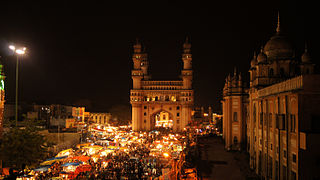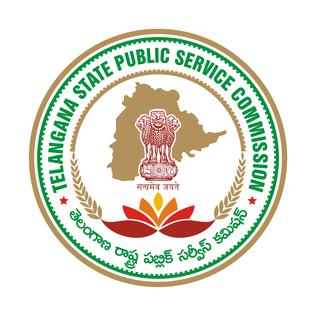
Hyderabad is the capital and largest city of the Indian state of Telangana. It occupies 650 km2 (250 sq mi) on the Deccan Plateau along the banks of the Musi River, in the northern part of Southern India. With an average altitude of 542 m (1,778 ft), much of Hyderabad is situated on hilly terrain around artificial lakes, including the Hussain Sagar lake, predating the city's founding, in the north of the city centre. According to the 2011 census of India, Hyderabad is the fourth-most populous city in India with a population of 6.9 million residents within the city limits, and has a population of 9.7 million residents in the metropolitan region, making it the sixth-most populous metropolitan area in India. With an output of US$74 billion, Hyderabad has the fifth-largest urban economy in India.

Hyderabad State was an independent monarchy/princely state located in the south-central Deccan region of Indian Subcontinent with its capital at the city of Hyderabad. It is now divided into the present-day state of Telangana, the Kalyana-Karnataka region of Karnataka, and the Marathwada region of Maharashtra in India.

Nizam of Hyderabad was the title of the ruler of Hyderabad State. Nizam is a shortened form of Niẓām ul-Mulk, which means Administrator of the Realm, and was the title bestowed upon Asaf Jah I when he was appointed Viceroy of the Deccan by the Mughal Emperor Farrukhsiyar. In addition to being the Mughal Viceroy (Naib) of the Deccan, Asaf Jah I was also the premier courtier of the Mughal Empire until 1724, when he established the independent monarchy of Hyderabad and adopted the title "Nizam of Hyderabad".

The Salar Jung Museum is an art museum located at Dar-ul-Shifa, on the southern bank of the Musi River in the city of Hyderabad, Telangana, India. It is one of the notable National Museums of India. Originally a private art collection of the Salar Jung family, it was endowed to the nation after the death of Salar Jung III. It was inaugurated on 16 December 1951.

Nizamabad or Induru is a city in the Indian state of Telangana. It is governed by municipal corporation and is the headquarters of the Nizamabad district. Although previously part of Hyderabad State and then Andhra Pradesh state, Nizamabad became a part of the newly formed state of Telangana by the Andhra Pradesh Reorganisation Act, 2014. It is located about 186 kilometres (116 mi) north of the state capital, Hyderabad.

Asaf Jah VI, also known as Sir Mir Mahboob Ali Khan Siddiqi Bayafandi, was the 6th Nizam of Hyderabad. He ruled Hyderabad State, one of the princely states of India, between 1869 and 1911.

The Telangana High Court is the High Court for the Indian state of Telangana. Founded by the 7th Nizam Mir Osman Ali Khan, initially, it was set up as High Court of Hyderabad for the then Princely State of Hyderabad Deccan and later renamed High Court of Andhra Pradesh, as it was set up on 5 November 1956 under the States Reorganisation Act, 1956. The Andhra Pradesh High Court was renamed as High Court of Judicature at Hyderabad in view of the bifurcation of Andhra Pradesh state.

Mir Farqunda Ali Khan commonly known as Nasir-ud-Daulah, was Nizam of Hyderabad, a princely state of British India, from 24 May 1829 until his death in 1857.

Sir Mir Turab Ali Khan, Salar Jung I,, known simply as Salar Jung I, was an Indian nobleman who served as Prime Minister of Hyderabad State between 1853 until his death in 1883. He also served as regent for the sixth Nizam, Asaf Jah VI between 1869 and 1883.

The Secunderabad Club is an elite club located in Secunderabad, India.

Nawab Syed Hussain Bilgrami, Imad-ul-Mulk Bahadur, CSI (1842-1926) was an Indian civil servant, politician, educationalist and an early leader of the All India Muslim League.

The Telangana Rebellion, natively known as Telangana Sayudha Poratam, was a communist-led insurrection of peasants against the princely state of Hyderabad in the region of Telangana that escalated out of agitations in 1944–46.

Greater Hyderabad Municipal Corporation (GHMC) is the civic body that oversees Hyderabad, the capital and largest city of the Indian state of Telangana. It is the local government for the city of Hyderabad. It is one of the largest municipal corporations in India with a population of 7.9 million and an area of 650 km2.

The Asaf Jahi was a Muslim dynasty that ruled the Hyderabad State. The family came to India in the late 17th century and became employees of the Mughal Empire. They were great patrons of Persian culture, language, and literature, and the family found ready patronage.

Osmania General Hospital (OGH) is one of the oldest hospitals in India located at Afzal Gunj, Hyderabad and is named after its founder – Mir Osman Ali Khan, the last Nizam of Hyderabad. It is run by the Government of Telangana, and is one of the largest in the state. It was built at a construction cost of ₹2,00,00,000.

Hyderabad railway station, popularly known as Hyderabad Deccan railway station or Nampally railway station, is located at Nampally, a locality in Hyderabad constructed and earlier run by the Nizam's Guaranteed State Railway of the Hyderabad State.

Raja Bahadur Venkatarama Reddy was a police officer who served as the Commissioner of Police of the Hyderabad City Police. He was the first Hindu Kotwal of Hyderabad State, as in the late 19th and early 20th century, during the rule of the Nizams, the powerful position of Kotwal of Hyderabad, was usually held by Muslims. His tenure lasted 14 years and commanded great respect among the public for his outstanding police administration.
Telangana has multiple institutes of higher education universities along with numerous primary and secondary schools.

The Telangana State Public Service Commission, chiefly, TSPSC is a body created by the Constitution of India to select applicants for civil service jobs in the Indian state of Telangana according to the merits of the applicants and the rules of reservation.
Nidigattu Sanjay, better known as N. Sanjay, is a Silver jubilee 1996-batch Regular Recruit (RR) Indian Police Service Officer belonging to Andhra Pradesh cadre. At present, Sanjay is the Chief of AP Criminal Investigation Department. He also holds full additional charges as Director-General of AP Disaster Response and Fire Services and as Director, AP Police Personnel and Training.



















